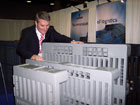
Packaging executives from the Sam’s Club division presented a scorecard with which suppliers can create a packaging baseline to measure future efficiencies. It also provides a comparative score with other manufacturers in their product categories.
Beginning in 2008, Wal-Mart buyers will use the scores when making sourcing decisions, according to Matt Kistler, vice president-packaging & product innovations at the Bentonville, AR, chain’s Sam’s Club division. “Price will always be important,” he says, but “in 2008, our buyers will begin to look at more than just price. If there is a dead heat between two products (competing for shelf space), this could make the decision (of which one to stock) a little easier.”
Use of the scorecard-which requires a $900 fee-is voluntary, Kistler emphasized. Unlike the chain’s 2003 RFID mandate, packaging reforms should save money, not generate costs for either suppliers or Wal-Mart. “We cannot disrupt the financial position of our suppliers and ourselves,” he says. “The unintended consequences of sustainability are quite amazing, however. There is green in green.” If all Wal-Mart’s 60,000 global suppliers use the scorecard, software fees will top $54 million.
Based on feedback from manufacturers such as Frito-Lay and other sources, Wal-Mart’s scorecard assigns packaging values based on eight metrics, including:
- material value (15% of score)
- product/package ratio (15%)
- cube utilization (15%)
- transportation (10%)
- recycled content (10%)
- recovery value (10%)
- renewable energy (5%)
- innovation (5%)
- greenhouse gases per ton of production (15%).
Instead of simply reducing the cost of an item’s package, Wal-Mart is encouraging manufacturers to wring waste out of the distribution pipeline. Shipping efficiencies have been elevated to a refined science by companies like Inter IKEA Systems BV, which optimizes unit load and container layout for global shipping. IKEA’s Atlanta-based OptiLogistics Inc. division provides a load shipping system that relies on disposable polypropylene legs that replace conventional pallets. The ISPM No. 15 international mandate to fumigate or heat treat wooden pallets used is expected to jumpstart plastic-pallet use.
Pallet pooling giant CHEPS estimates plastic pallets have a useful life of 150-200 turns, compared to three turns for wooden pallets. Returnability remains an impediment, however: Germany’s Paul Craemer GmbH supplied RFID-tagged sanitary pallets to CHEPS at $60 each recently, and within a year, 100,000 were lost in the supply chain, reports Alexander Korell, Craemer’s export area manager.
Wal-Mart rates packaging materials low to high, depending on greenhouse gases generated in their manufacture. While PVC is the only material in the least favorable group, Kistler dismissed the suggestion the retailer was trying to steer manufacturers toward greener materials. Instead, the issue is “right-sizing,” an effort already underway in Wal-Mart’s private-label business. Right sizing 277 SKUs has saved the firm $3.5 million in diesel fuel and slashed stock-outs in half, he said.
For more information:
Alexander Korell, Paul Craemer GmbH, 011-49 5245/43-116, korell@craemer.com

Pottery packaging
The Barcelona area firm hopes to mine renewed US interest in ecological packaging to expand food applications for its ceramic containers. Ice cream, dips and ready-to-eat meals from the UK’s Marks & Spencer and Tesco, France’s Danone and Spain’s Frigo-Unilever have hit the market in Arbresa’s terra cotta in recent years. “The lines have been incredibly successful,” says Mark Caul, Marks & Spencer’s packaging technologist manager.
Reusable packaging is big in Latin America, points out O-I Inc.’s Kevin Stevens, vice president-global marketing, where threadless glass jars for jelly and other foods remain popular. Secondary uses won’t get a lift from the Wal-Mart sustainability initiative: company executives flatly reject re-use as a criterion in their assessments of packaging. Still, the absence of off flavors and the ability to re-use terra cotta bowls have made them popular in Europe, says Arbresa’s Marie-Pierre Galamon, export executive. The company has its own red-clay quarry and an “80 percent automated factory” that can output 60,000 ceramic pieces a day, she says.
For more information:
Marie-Pierre Galamon, Arbresa SA, 011-34 972 870 136, mpgalamon@arbresa.es